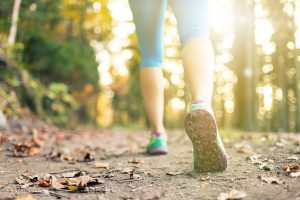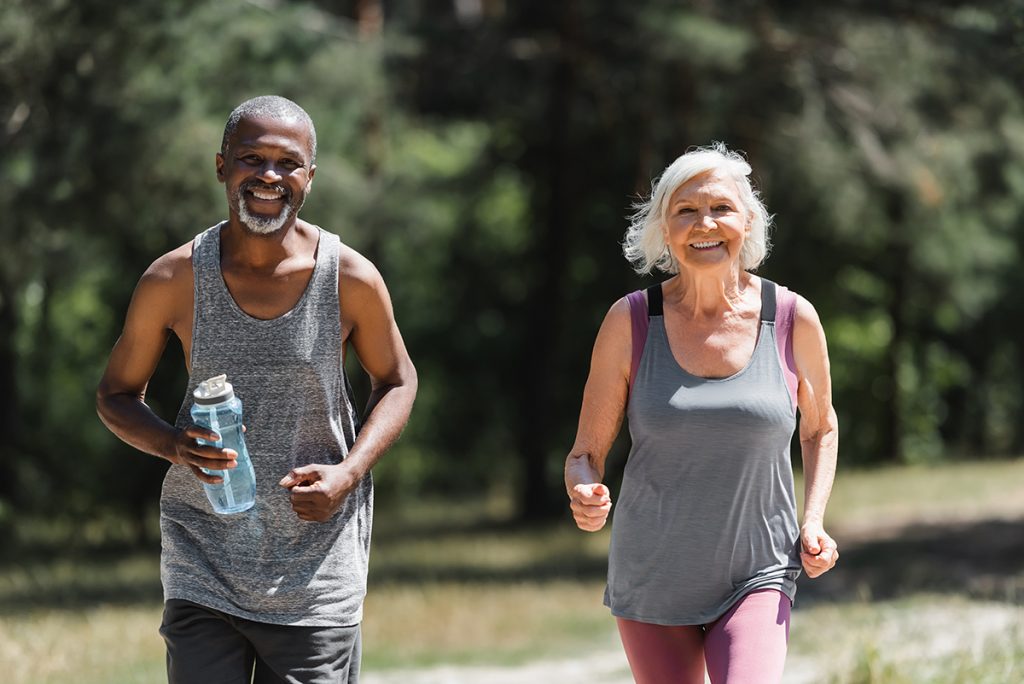
Research indicates that walking can help seniors live longer, healthier lives. Regardless of your current fitness level, walking has multiple health benefits that are backed by peer-reviewed research.
Let’s jump in!
What are the Research-Based Benefits of Walking?
Research has shown that walking can also enhance sleep quality [1], boost mental health [2], and may lead to improvements in the following areas:
- Bodyweight [3, 4]
- Balance and coordination [5]
- Cardiovascular health [6]
- Blood pressure [7, 8]
- Quality of life [9],
- Bone and joint health [10]
- Cholesterol levels [11]
Let’s take a closer look at how some of these research-backed benefits might be interesting to you.
Walking Leads to Improved Balance and Can Help Prevent Falls
Falls can cause serious injuries and can lower quality of life – especially for seniors. Walking can help you consistently maintain and improve your balance [12].
As you gain confidence, walking on hiking trails can add an extra challenge which can lead to increased core strength, improved cardiovascular health, and enhanced balance.
You may also want to check in with a physio-therapist or certified personal trainer and begin implementing some basic balance exercises to build additional confidence with walking and hiking.
Ever Find That As You Get Older, Your Sleeps Get Worse?
In their randomized controlled study consisting of fifty-four healthy adults, Drs Boros and Wang (2021) found that those who walked one hour per day saw significant improvements in terms of their sleep quality and duration over a 12-week intervention [13].
Who doesn’t want better sleep!?
 What Muscles Does Walking Work?
What Muscles Does Walking Work?
In terms of the lower body, walking targets the glutes (both the gluteus maximus and gluteus maxiumus), quads, calves (gastrocnemius and soleus), hamstrings, and tibialis anterior muscles [14].
Your back foot generates the force needed to push off the ground by contracting the glutes, quadriceps, and calve muscles of the back leg. In order to lift your foot off the ground, you contract your hamstrings [15] and tibialis anterior (TA).
When the TA contracts, your toes point upward which prevents your foot from dragging on the ground [16]. These muscles need to work even harder when going uphill or upstairs.
How often a week should you walk in order to see benefits?
By following the guidelines presented by the US Department of Health and Human Services in The Physical Activity Guidelines for Americans (2nd edition), you might want to aim for 30-60 minutes of walking each day at a moderate intensity [17].
Depending on your level of fitness, this can be a healthy amount of walking to start with and will provide plenty of the research-based benefits listed above.
Personally, I aim to walk 10,000 steps per day. This usually takes 1-1.5 hours and gives me plenty of time for exercise, fresh air, and to listen to audiobooks.
Walk More, By Joining A Walking Group!
Drs. Hanson and Jones (2015) conducted a meta-analysis involving 1843 participants who had joined walking groups.
The researchers [18] found that walking has wide-spanning health benefits such as significant reductions in the following areas:
- Blood pressure
- Resting heart rate
- Body fat
- Body mass index
- Total cholesterol
- Waist circumference
- Depression
Remember to consult with your doctor or primary health care provider before starting an exercise program.
Summary
Ready to learn other research-backed ways to live a longer, healthier life? Check out this article to learn how Reducing Calories May Help You Live Longer.
Chad Alexander BSc, MEd, BEd is a personal trainer, weight loss coach, and blogger at Fitness Minimalists. He is on a mission to educate and empower people to level up their fitness with only the essentials to live more confident and adventurous lives.
References
- Wang, F., Boros, S. The effect of daily walking exercise on sleep quality in healthy young adults. Sport Sci Health 17, 393–401 (2021). https://doi.org/10.1007/s11332-020-00702-x
- Bang, K. S., Lee, I., Kim, S., Lim, C. S., Joh, H. K., Park, B. J., & Song, M. K. (2017). The effects of a campus forest-walking program on undergraduate and graduate students’ physical and psychological health. International journal of environmental research and public health, 14(7), 728.
- Richardson, C. R., Newton, T. L., Abraham, J. J., Sen, A., Jimbo, M., & Swartz, A. M. (2008). A meta-analysis of pedometer-based walking interventions and weight loss. The Annals of Family Medicine, 6(1), 69-77.
- Hanson, S., & Jones, A. (2015). Is there evidence that walking groups have health benefits? A systematic review and meta-analysis. British journal of sports medicine, 49(11), 710-715.
- Roberts, B. L. (1989). Effects of walking on balance among elders. Nursing Research, 38(3), 180–182. https://doi.org/10.1097/00006199-198905000-00021
- Murtagh EM, Murphy MH, Boone-Heinonen J. Walking: the first steps in cardiovascular disease prevention. Curr Opin Cardiol. 2010 Sep;25(5):490-6. doi: 10.1097/HCO.0b013e32833ce972. PMID: 20625280; PMCID: PMC3098122.
- Murphy MH, Nevill AM, Murtagh EM, Holder RL. The effect of walking on fitness, fatness and resting blood pressure: a meta-analysis of randomised, controlled trials. Prev Med. 2007 May;44(5):377-85. doi: 10.1016/j.ypmed.2006.12.008. Epub 2006 Dec 24. PMID: 17275896.
- Hanson, S., & Jones, A. (2015). Is there evidence that walking groups have health benefits? A systematic review and meta-analysis. British journal of sports medicine, 49(11), 710-715.
- Hanson, S., & Jones, A. (2015). Is there evidence that walking groups have health benefits? A systematic review and meta-analysis. British journal of sports medicine, 49(11), 710-715.
- White, M.K., Martin, R.B., Yeater, R.A. et al. The effects of exercise on the bones of postmenopausal women. International Orthopaedics 7, 209–214 (1984). https://doi.org/10.1007/BF00266829
- Ready AE, Drinkwater DT, Ducas J, Fitzpatrick DW, Brereton DG, Oades SC. Walking program reduces elevated cholesterol in women postmenopause. Can J Cardiol. 1995 Nov;11(10):905-12. PMID: 7489529
- Roberts, B. L. (1989). Effects of walking on balance among elders. Nursing Research, 38(3), 180–182. https://doi.org/10.1097/00006199-198905000-00021
- Wang, F., Boros, S. The effect of daily walking exercise on sleep quality in healthy young adults. Sport Sci Health 17, 393–401 (2021). https://doi.org/10.1007/s11332-020-00702-x
- Pellegrini, B., Peyré-Tartaruga, L. A., Zoppirolli, C., Bortolan, L., Bacchi, E., Figard-Fabre, H., & Schena, F. (2015). Exploring muscle activation during nordic walking: a comparison between conventional and uphill walking. PloS one, 10(9), e0138906 https://doi.org/10.1371/journal.pone.0138906
- Murdock CJ, Mudreac A, Agyeman K. Anatomy, Abdomen and Pelvis, Rectus Femoris Muscle. [Updated 2021 Aug 10]. In: StatPearls [Internet]. Treasure Island (FL): StatPearls Publishing; 2022 Jan-. Available from: https://www.ncbi.nlm.nih.gov/books/NBK539897
- Juneja P, Hubbard JB. Anatomy, Bony Pelvis and Lower Limb, Tibialis Anterior Muscles. [Updated 2021 Aug 13]. In: StatPearls [Internet]. Treasure Island (FL): StatPearls Publishing; 2022 Jan-. Available from: https://www.ncbi.nlm.nih.gov/books/NBK513304/
- Marquez, D. X., McTiernan, A., Pate, R. R., Pescatello, L. S., & Whitt-Glover, M. C. (n.d. ). The Scientific Foundation for the Physical Activity Guidelines for Americans, 2nd Edition, Journal of Physical Activity and Health, 16(1), 1-11. Retrieved Jun 30, 2022, from https://journals.humankinetics.com/view/journals/jpah/16/1/article-p1.xml
- Hanson, S., & Jones, A. (2015). Is there evidence that walking groups have health benefits? A systematic review and meta-analysis. British journal of sports medicine, 49(11), 710-715.

